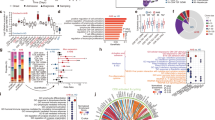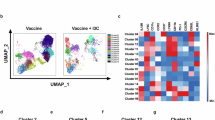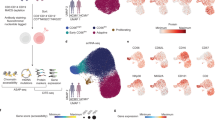Abstract
Hepatic natural killer (NK) cells mediate antigen-specific contact hypersensitivity (CHS) in mice deficient in T cells and B cells. We report here that hepatic NK cells, but not splenic or naive NK cells, also developed specific memory of vaccines containing antigens from influenza, vesicular stomatitis virus (VSV) or human immunodeficiency virus type 1 (HIV-1). Adoptive transfer of virus-sensitized NK cells into naive recipient mice enhanced the survival of the mice after lethal challenge with the sensitizing virus but not after lethal challenge with a different virus. NK cell memory of haptens and viruses depended on CXCR6, a chemokine receptor on hepatic NK cells that was required for the persistence of memory NK cells but not for antigen recognition. Thus, hepatic NK cells can develop adaptive immunity to structurally diverse antigens, an activity that requires NK cell–expressed CXCR6.
This is a preview of subscription content, access via your institution
Access options
Subscribe to this journal
Receive 12 print issues and online access
$259.00 per year
only $21.58 per issue
Buy this article
- Purchase on SpringerLink
- Instant access to full article PDF
Prices may be subject to local taxes which are calculated during checkout







Similar content being viewed by others
References
Bassing, C.H., Swat, W. & Alt, F.W. The mechanism and regulation of chromosomal V(D)J recombination. Cell 109 Suppl, S45–S55 (2002).
Crowle, A.J. Delayed hypersensitivity in mice; its detection by skin tests and its passive transfer. Science 130, 159–160 (1959).
Orme, I.M. & Cooper, A.M. Cytokine/chemokine cascades in immunity to tuberculosis. Immunol. Today 20, 307–312 (1999).
Dhabhar, F.S., Satoskar, A.R., Bluethmann, H., David, J.R. & McEwen, B.S. Stress-induced enhancement of skin immune function: A role for γ interferon. Proc. Natl. Acad. Sci. USA 97, 2846–2851 (2000).
Phanuphak, P., Moorhead, J.W. & Claman, H.N. Tolerance and contact sensitivity to DNFB in mice. II. Specific in vitro stimulation with a hapten, 2,4-dinitrobenzene sulfonic acid (DNB-SO3Na). J. Immunol. 112, 849–851 (1974).
Lanier, L.L. Up on the tightrope: natural killer cell activation and inhibition. Nat. Immunol. 9, 495–502 (2008).
Lanier, L.L. NK cell recognition. Annu. Rev. Immunol. 23, 225–274 (2005).
Mandelboim, O. et al. Recognition of haemagglutinins on virus-infected cells by NKp46 activates lysis by human NK cells. Nature 409, 1055–1060 (2001).
Gazit, R. et al. Lethal influenza infection in the absence of the natural killer cell receptor gene Ncr1. Nat. Immunol. 7, 517–523 (2006).
Smith, H.R. et al. Recognition of a virus-encoded ligand by a natural killer cell activation receptor. Proc. Natl. Acad. Sci. USA 99, 8826–8831 (2002).
Kim, S. et al. Licensing of natural killer cells by host major histocompatibility complex class I molecules. Nature 436, 709–713 (2005).
Jonsson, A.H. & Yokoyama, W.M. Natural killer cell tolerance licensing and other mechanisms. Adv. Immunol. 101, 27–79 (2009).
Sun, J.C., Beilke, J.N. & Lanier, L.L. Adaptive immune features of natural killer cells. Nature 457, 557–561 (2009).
Scalzo, A.A., Manzur, M., Forbes, C.A., Brown, M.G. & Shellam, G.R. NK gene complex haplotype variability and host resistance alleles to murine cytomegalovirus in wild mouse populations. Immunol. Cell Biol. 83, 144–149 (2005).
Martin, M.P. et al. Epistatic interaction between KIR3DS1 and HLA-B delays the progression to AIDS. Nat. Genet. 31, 429–434 (2002).
Alter, G. et al. Differential natural killer cell-mediated inhibition of HIV-1 replication based on distinct KIR/HLA subtypes. J. Exp. Med. 204, 3027–3036 (2007).
O'Leary, J.G., Goodarzi, M., Drayton, D.L. & von Andrian, U.H. T cell– and B cell–independent adaptive immunity mediated by natural killer cells. Nat. Immunol. 7, 507–516 (2006).
Boehncke, W.H. et al. Leukocyte extravasation as a target for anti-inflammatory therapy—Which molecule to choose? Exp. Dermatol. 14, 70–80 (2005).
DiSanto, J.P., Muller, W., Guy-Grand, D., Fischer, A. & Rajewsky, K. Lymphoid development in mice with a targeted deletion of the interleukin 2 receptor γ chain. Proc. Natl. Acad. Sci. USA 92, 377–381 (1995).
Paust, S., Senman, B. & von Andrian, U.H. Adaptive immune responses mediated by natural killer cells. Immunol. Rev. 235, 286–296 (2010).
Matangkasombut, P. et al. Lack of iNKT cells in patients with combined immune deficiency due to hypomorphic RAG mutations. Blood 111, 271–274 (2008).
Geissmann, F. et al. Intravascular immune surveillance by CXCR6+ NKT cells patrolling liver sinusoids. PLoS Biol. 3, e113 (2005).
Day, C.E. et al. A novel method for isolation of human lung T cells from lung resection tissue reveals increased expression of GAPDH and CXCR6. J. Immunol. Methods 342, 91–97 (2009).
Matloubian, M., David, A., Engel, S., Ryan, J.E. & Cyster, J.G. A transmembrane CXC chemokine is a ligand for HIV-coreceptor Bonzo. Nat. Immunol. 1, 298–304 (2000).
van der Voort, R. et al. An alternatively spliced CXCL16 isoform expressed by dendritic cells is a secreted chemoattractant for CXCR6+ cells. J. Leukoc. Biol. 87, 1029–1039 (2010).
Sato, T. et al. Role for CXCR6 in recruitment of activated CD8+ lymphocytes to inflamed liver. J. Immunol. 174, 277–283 (2005).
Park, B.K., Tingle, M.D., Grabowski, P.S., Coleman, J.W. & Kitteringham, N.R. Drug-protein conjugates–XI. Disposition and immunogenicity of dinitrofluorobenzene, a model compound for the investigation of drugs as haptens. Biochem. Pharmacol. 36, 591–599 (1987).
Di Santo, J.P., Colucci, F. & Guy-Grand, D. Natural killer and T cells of innate and adaptive immunity: lymphoid compartments with different requirements for common gamma chain-dependent cytokines. Immunol. Rev. 165, 29–38 (1998).
Jamieson, A.M., Isnard, P., Dorfman, J.R., Coles, M.C. & Raulet, D.H. Turnover and proliferation of NK cells in steady state and lymphopenic conditions. J. Immunol. 172, 864–870 (2004).
Quan, F.S., Huang, C., Compans, R.W. & Kang, S.M. Virus-like particle vaccine induces protective immunity against homologous and heterologous strains of influenza virus. J. Virol. 81, 3514–3524 (2007).
Kang, S.M., Song, J.M., Quan, F.S. & Compans, R.W. Influenza vaccines based on virus-like particles. Virus Res. 143, 140–146 (2009).
Hangartner, L., Zinkernagel, R.M. & Hengartner, H. Antiviral antibody responses: the two extremes of a wide spectrum. Nat. Rev. Immunol. 6, 231–243 (2006).
Draghi, M. et al. NKp46 and NKG2D recognition of infected dendritic cells is necessary for NK cell activation in the human response to influenza infection. J. Immunol. 178, 2688–2698 (2007).
Wang, B.Z. et al. Incorporation of high levels of chimeric human immunodeficiency virus envelope glycoproteins into virus-like particles. J. Virol. 81, 10869–10878 (2007).
Shultz, L.D. et al. NOD/LtSz-Rag1null mice: an immunodeficient and radioresistant model for engraftment of human hematolymphoid cells, HIV infection, and adoptive transfer of NOD mouse diabetogenic T cells. J. Immunol. 164, 2496–2507 (2000).
Wilbanks, A. et al. Expression cloning of the STRL33/BONZO/TYMSTR ligand reveals elements of CC, CXC, and CX3C chemokines. J. Immunol. 166, 5145–5154 (2001).
Szczepanik, M. et al. B-1 B cells mediate required early T cell recruitment to elicit protein-induced delayed-type hypersensitivity. J. Immunol. 171, 6225–6235 (2003).
Aktas, E., Kucuksezer, U.C., Bilgic, S., Erten, G. & Deniz, G. Relationship between CD107a expression and cytotoxic activity. Cell. Immunol. 254, 149–154 (2009).
Raulet, D.H. A sense of something missing. Nature 358, 21–22 (1992).
Carbone, T. et al. CD56highCD16−CD62L− NK cells accumulate in allergic contact dermatitis and contribute to the expression of allergic responses. J. Immunol. 184, 1102–1110 (2010).
Scholz, F. et al. Constitutive expression and regulated release of the transmembrane chemokine CXCL16 in human and murine skin. J. Invest. Dermatol. 127, 1444–1455 (2007).
Martin, M.P. et al. Innate partnership of HLA-B and KIR3DL1 subtypes against HIV-1. Nat. Genet. 39, 733–740 (2007).
Limou, S. et al. Multiple-cohort genetic association study reveals CXCR6 as a new chemokine receptor involved in long-term nonprogression to AIDS. J. Infect. Dis. 202, 908–915 (2010).
Berahovich, R.D., Lai, N.L., Wei, Z., Lanier, L.L. & Schall, T.J. Evidence for NK cell subsets based on chemokine receptor expression. J. Immunol. 177, 7833–7840 (2006).
Cao, X. et al. Defective lymphoid development in mice lacking expression of the common cytokine receptor γ chain. Immunity 2, 223–238 (1995).
Acknowledgements
We thank G. Cheng and J.D. Sullivan for technical support and A. Wagers (Harvard Medical School) for Act(EGFP) mice. Supported by the US National Institutes of Health (AI069259, AI072252, AI078897, HL56949 and AR42689), the Ragon Institute (U.H.v.A.), the Cancer Research Institute (S.P.) and the Ragon Institute of MIT, Harvard and MGH (S.P.).
Author information
Authors and Affiliations
Contributions
S.P. and U.H.v.A. designed the study; S.P., H.S.G., B.Z.W. and M.F. did experiments; S.P., A.T. and B.S. collected and analyzed data; E.A.M., H.S.G., B.Z.W. and R.H.C. provided reagents; E.A.M., M.S. and P.W.A. provided technical support and conceptual advice; and S.P. and U.H.v.A. wrote the manuscript.
Corresponding author
Ethics declarations
Competing interests
The authors declare no competing financial interests.
Supplementary information
Supplementary Text and Figures
Supplementary Figures 1–6 (PDF 1189 kb)
Rights and permissions
About this article
Cite this article
Paust, S., Gill, H., Wang, BZ. et al. Critical role for the chemokine receptor CXCR6 in NK cell–mediated antigen-specific memory of haptens and viruses. Nat Immunol 11, 1127–1135 (2010). https://doi.org/10.1038/ni.1953
Received:
Accepted:
Published:
Issue date:
DOI: https://doi.org/10.1038/ni.1953
This article is cited by
-
Roles of natural killer cells in immunity to cancer, and applications to immunotherapy
Nature Reviews Immunology (2023)
-
Autologous dendritic cell vaccination against HIV-1 induces changes in natural killer cell phenotype and functionality
npj Vaccines (2023)
-
Transcriptomic perspectives of memory-like NK cells and aging
Genome Medicine (2022)
-
Immunoglobulin-like receptors and the generation of innate immune memory
Immunogenetics (2022)
-
IL-21 and IFNα therapy rescues terminally differentiated NK cells and limits SIV reservoir in ART-treated macaques
Nature Communications (2021)



